国际海事组织综述概要
[精华]国际海事组织
![[精华]国际海事组织](https://uimg.taocdn.com/363bead4db38376baf1ffc4ffe4733687e21fc22.webp)
国际海事组织中文名称:国际海事组织英文名称:International Maritime Organization;IMO定义1:联合国主管海运事务的专门机构。
它是以促进海上安全和防止海上污染为目标,从事国际间协调管理的技术性组织。
应用学科:船舶工程(一级学科);船舶种类及船舶检验、国际公约和证书(二级学科)定义2:1948年成立的负责推进各国在海运活动中航行安全的国际组织。
应用学科:海洋科技(一级学科)定义3:联合国主管海运事务的专门机构。
它是以促进海上安全和防止海上污染为目标,从事国际间协调管理的技术性组织。
应用学科:水产学(一级学科);渔业船舶及渔业机械(二级学科)以上内容由全国科学技术名词审定委员会审定公布国际海事组织(InternationalMaritimeOrganization--IMO)是联合国负责海上航行安全和防止船舶造成海洋污染的一个专门机构,总部设在伦敦。
该组织最早成立于1959年1月6日,原名“政府间海事协商组织”,1982年5月改为现名,到2006年10月,已有167个正式成员。
目录一个促进各国政府和各国航运业界在改进海上安全,防止海洋污染与及海事技术合作的国际组织。
总部设在伦敦。
该组织最早成立于1959年1月6日,原名“政府间海事协商组织”,1982年5月改为现名,现有167个正式成员(2006年10月)。
宗旨该组织宗旨为促进各国间的航运技术合作,鼓励各国在促进海上安全,提高船舶航行效率,防止和控制船舶对海洋污染方面采取统一的标准,处理有关的法律问题。
理事会成员国际海事组织理事会共有40名成员,分为A、B、C三类。
其中10个A 类理事为航运大国,10个B类理事为海上贸易量最大国家,20个C类理事为地区代表。
理事会是该组织的重要决策机构。
该组织每两年举行一次大会,改选理事会和主席。
当选主席和理事国任期2年。
组织机构国际海事组织设有大会和理事会,以及海上安全、法律、海上环境保护、技术合作、便利运输等5个委员会和一个秘书处。
21个主要国际海事组织机构
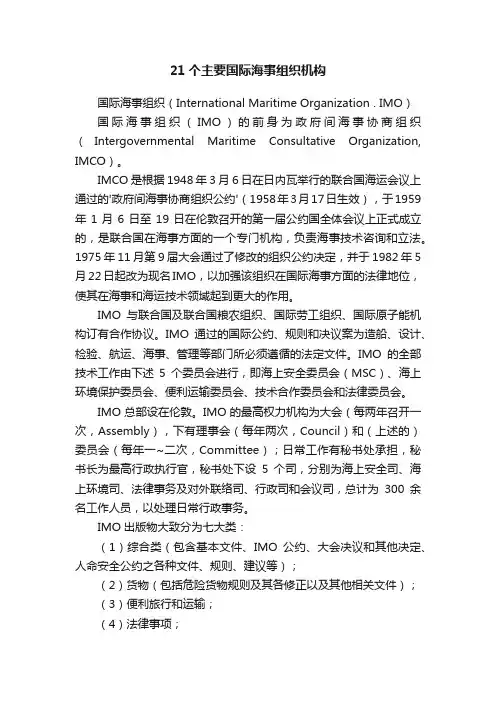
21个主要国际海事组织机构国际海事组织(International Maritime Organization . IMO)国际海事组织(IMO)的前身为政府间海事协商组织(Intergovernmental Maritime Consultative Organization, IMCO)。
IMCO是根据1948年3月6日在日内瓦举行的联合国海运会议上通过的'政府间海事协商组织公约'(1958年3月17日生效),于1959年1月6日至19日在伦敦召开的第一届公约国全体会议上正式成立的,是联合国在海事方面的一个专门机构,负责海事技术咨询和立法。
1975年11月第9届大会通过了修改的组织公约决定,并于1982年5月22日起改为现名IMO,以加强该组织在国际海事方面的法律地位,使其在海事和海运技术领域起到更大的作用。
IMO与联合国及联合国粮农组织、国际劳工组织、国际原子能机构订有合作协议。
IMO通过的国际公约、规则和决议案为造船、设计、检验、航运、海事、管理等部门所必须遵循的法定文件。
IMO的全部技术工作由下述5个委员会进行,即海上安全委员会(MSC)、海上环境保护委员会、便利运输委员会、技术合作委员会和法律委员会。
IMO总部设在伦敦。
IMO的最高权力机构为大会(每两年召开一次,Assembly),下有理事会(每年两次,Council)和(上述的)委员会(每年一~二次,Committee);日常工作有秘书处承担,秘书长为最高行政执行官,秘书处下设5个司,分别为海上安全司、海上环境司、法律事务及对外联络司、行政司和会议司,总计为300余名工作人员,以处理日常行政事务。
IMO出版物大致分为七大类:(1)综合类(包含基本文件、IMO公约、大会决议和其他决定、人命安全公约之各种文件、规则、建议等);(2)货物(包括危险货物规则及其各修正以及其他相关文件);(3)便利旅行和运输;(4)法律事项;(5)海上环境保护;(6)船舶技术。
国际海事组织公约概览
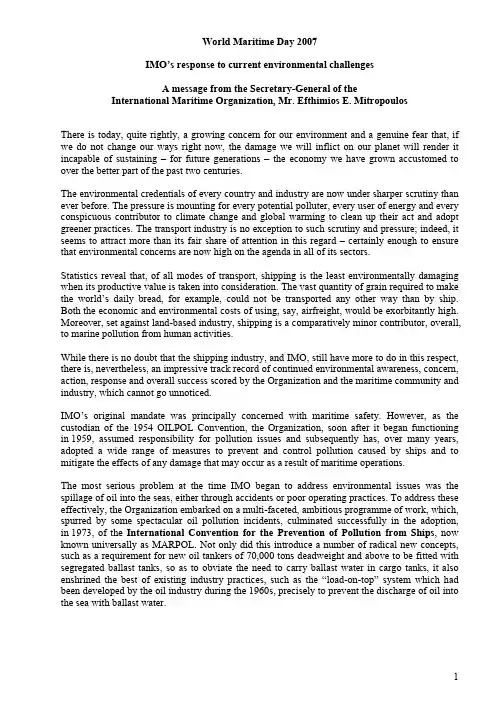
World Maritime Day 2007IMO’s response to current environmental challengesA message from the Secretary-General of theInternational Maritime Organization, Mr. Efthimios E. MitropoulosThere is today, quite rightly, a growing concern for our environment and a genuine fear that, if we do not change our ways right now, the damage we will inflict on our planet will render it incapable of sustaining – for future generations – the economy we have grown accustomed to over the better part of the past two centuries.The environmental credentials of every country and industry are now under sharper scrutiny than ever before. The pressure is mounting for every potential polluter, every user of energy and every conspicuous contributor to climate change and global warming to clean up their act and adopt greener practices. The transport industry is no exception to such scrutiny and pressure; indeed, it seems to attract more than its fair share of attention in this regard – certainly enough to ensure that environmental concerns are now high on the agenda in all of its sectors.Statistics reveal that, of all modes of transport, shipping is the least environmentally damaging when its productive value is taken into consideration. The vast quantity of grain required to make the world’s daily bread, for example, could not be transported any other way than by ship. Both the economic and environmental costs of using, say, airfreight, would be exorbitantly high. Moreover, set against land-based industry, shipping is a comparatively minor contributor, overall, to marine pollution from human activities.While there is no doubt that the shipping industry, and IMO, still have more to do in this respect, there is, nevertheless, an impressive track record of continued environmental awareness, concern, action, response and overall success scored by the Organization and the maritime community and industry, which cannot go unnoticed.IMO’s original mandate was principally concerned with maritime safety. However, as the custodian of the 1954 OILPOL Convention, the Organization, soon after it began functioning in 1959, assumed responsibility for pollution issues and subsequently has, over many years, adopted a wide range of measures to prevent and control pollution caused by ships and to mitigate the effects of any damage that may occur as a result of maritime operations.The most serious problem at the time IMO began to address environmental issues was the spillage of oil into the seas, either through accidents or poor operating practices. To address these effectively, the Organization embarked on a multi-faceted, ambitious programme of work, which, spurred by some spectacular oil pollution incidents, culminated successfully in the adoption, in 1973, of the International Convention for the Prevention of Pollution from Ships, now known universally as MARPOL. Not only did this introduce a number of radical new concepts, such as a requirement for new oil tankers of 70,000 tons deadweight and above to be fitted with segregated ballast tanks, so as to obviate the need to carry ballast water in cargo tanks, it also enshrined the best of existing industry practices, such as the “load-on-top” system which had been developed by the oil industry during the 1960s, precisely to prevent the discharge of oil into the sea with ballast water.More than 30 years later, albeit much expanded, amended and updated, the MARPOL Convention remains the most important international convention covering the prevention of pollution by ships, whether from operational or accidental causes. Today, MARPOL has six separate annexes, which set out regulations dealing with pollution from ships by oil; by noxious liquid substances carried in bulk; harmful substances carried by sea in packaged form; sewage, garbage; and the prevention of air pollution from ships. There can be no doubt that, in conjunction with a variety of other measures, MARPOL has laid the foundation for substantial and continued reductions in pollution from ships and, this, despite a massive increase in world seaborne trade.According to shipping market analysts, world seaborne trade increased by around 135 per cent between 1985 and 2006. Oil and petroleum products accounted for a significant part of this increase, rising by a similar percentage. In sharp contrast, estimates of the quantity of oil spilled during the same period show a steady reduction by some 85 per cent. Figures reveal that, despite the rare major accident, which can cause a spike in the annual statistics, the overall trend demonstrates a continuing improvement, both in the number of oil spills and quantity of oil spilled each year.In the current decade, the average number of oil spills over 700 tonnes has shrunk from over 25 in the 1970s to just 3.7. It is interesting to note, in this context, that the biggest single “decade-to-decade” reduction was from the 1970s to the 1980s, coinciding with the adoption and entry into force of the MARPOL Convention, which is rightly credited with having had a substantial positive impact in decreasing the amount of oil that enters the sea from maritime transportation activities. One major oil company has estimated that the tankers it owns, or uses under long-term lease, spill less than one teaspoon of oil for every million gallons transported; while tanker owners take pride in statistics that show that 99.9996 per cent of all oil transported by sea is delivered safely and without impact on the marine environment.While always advocating a global approach, MARPOL, nevertheless, recognizes that some areas need protection over and above that sought under normal circumstances. To this end, it defines certain sea areas as “Special Areas”, in which the adoption of special mandatory measures for the prevention of sea pollution is required, so that such areas are provided with a level of protection higher than elsewhere. Moreover, IMO has adopted criteria for the identification and designation of “Particularly Sensitive Sea Areas”, which are deemed to require an even higher degree of protection because of their particular significance for ecological or socio-economic or scientific reasons, and because they may be vulnerable to damage by international maritime activities.IMO’s environmental work in recent years has covered a remarkably broad canvas, embracing everything, from the quality of our atmosphere to the microscopic aquatic life-forms that can be transported around the world in ships’ ballast water and deposited in alien local ecosystems where, by disrupting their delicate balance, they can cause immense damage.IMO’s work on this latter topic led to the adoption, in February 2004, of the Ballast Water Management Convention, and is still continuing today. Another significant milestone for the protection of the marine environment was reached in March 2006, with the entry into force of the 1996 Protocol to the 1972 Convention on the Prevention of Marine Pollution by Dumping of Wastes and Other Matter, which represents a major change of approach to the question of how to regulate the use of the sea as a depository for waste materials in that, in essence, dumping is now prohibited, except for materials on an approved list.Other IMO Conventions deal with issues such as the use of harmful anti-fouling paint on ships’ hulls; preparedness, response and co-operation in tackling pollution from oil and from hazardous and noxious substances; and the right of States to intervene on the high seas to prevent, mitigate or eliminate danger to their coastlines or related interests from pollution following a maritime casualty.The issue of ship recycling has also become a growing concern, not only from the environmental point of view but also with regard to the occupational health and safety of workers in the industry. IMO is currently developing a new mandatory instrument providing legally binding and globally applicable ship-recycling regulations for international shipping and recycling facilities, which is due for adoption in the 2008-2009 biennium. And, in May of this year, IMO adopted a new Convention on the removal of wrecks that may present either a hazard to navigation or a threat to the marine and coastal environments, or both.Although IMO’s traditional role is dealing with shipping and shipping-related accidents, we have, from time-to-time, also become involved in the aftermath of marine pollution incidents emanating from sources outside shipping operations. There is sound basis in international law for our participation in the response to such incidents, through such treaties as the UN Convention on the Law of the Sea and the International Convention on Oil Pollution Preparedness, Response and Co-operation. Last year, for example, we helped to draw up and implement an action plan to assist the authorities in Lebanon with the clean-up of coastal oil pollution following an air-strike on a refinery. The plan was agreed at an international meeting convened by IMO and the United Nations Environment Programme (UNEP) in Piraeus, Greece, and its execution was supervised by the IMO-administered Regional Marine Pollution Emergency Response Centre for the Mediterranean Sea (REMPEC) and the Minister of the Environment of Lebanon.But perhaps the most significant threat to our environment today concerns atmospheric pollution. And, once again, although the shipping industry is but a small contributor to the total volume of gas emissions – compared to road vehicles, aviation and public utilities, such as power stations – atmospheric pollution from ships has, nevertheless, been significantly reduced in the last decade and IMO continues to work towards further reductions as the evidence mounts and the world becomes more aware and more concerned about the further damage that might be caused if, from our various perspectives as Governments, industry and individuals, we do not address the challenges posed by air pollution, global warming and climate change.A good deal has already been done by the shipping sector. Annex VI of MARPOL, for example, set, for the first time, limits on sulphur oxide (SOx) and nitrogen oxide (NOx) emissions from ship exhausts; prohibited deliberate emissions of ozone-depleting substances; and put a global cap on the sulphur content of fuel oil. It also contains provisions allowing for special SOx Emission Control Areas to be established (such as, for example, those agreed for the Baltic and North Sea areas), with more stringent controls on sulphur emissions. However, although the Annex entered into force in 2005, it had actually been adopted as long ago as 1997. As a result, a comprehensive review of its provisions, taking into account experience gained thus far in its implementation, as well as improvements in engine and fuel technology, is currently underway at IMO.Whether we like it or not, there is no avoiding the fact that the modern world is utterly dependent on motorized transport systems that run largely on fossil fuels. Moreover, it is also a fact of life that the use of fossil fuels carries an environmental burden. An engine burning fossil fuel will emit a quantity of so-called greenhouse gases (GHGs), principally CO2, and these emissions are now widely accepted as being significant contributory factors towards global warming and climate change.Although no mandatory instrument has yet been adopted by IMO to cover the emission of GHGs from ships, the Organization has given ample consideration to the matter, leading to the adoption, in December 2003, of an Assembly resolution on the reduction of such emissions from ships.The most comprehensive assessment to date of the contribution made by international shipping to climate change is contained in the IMO Study on GHG Emissions from Ships published in June 2000. This study identified a number of areas in which there was considerable potential for the further reduction of CO2 emissions from ships, such as optimization of hull shape, hull maintenance, propeller design and maintenance, fuel choices, machinery monitoring, ship-routeing considerations, and optimizing vessel trim, engine performance, propeller pitch and rudder angles. The study cautioned, however, that if none of the measures are applied, the projected annual growth in the world fleet size could lead to an increase in fuel consumption of some 72 per cent between the years 2000 and 2020.This study is now being updated, and a work plan with a timetable has been adopted for IMO’s future work on the reduction of GHGs from ships, in which the Organization intends to maintain its leading position, co-operating closely with international shipping and with other relevant UN bodies, to avoid unilateral action either on a global, regional or national level.* * *IMO has, over the years, adopted a wide range of measures to prevent and control pollution caused by ships and to mitigate the effects of any damage that may occur. These are all positive proof of the firm determination of Governments and the industry to reduce, to the barest minimum, the impact that shipping may have on our fragile environment. There remain, however, serious concerns at the slow pace of ratification of IMO’s environmental conventions. It took almost eight years, for example, for MARPOL’s Annex VI to reach its entry into force criteria – by which time, as mentioned earlier, it needed to undergo a substantial review; and neither the 2004 Ballast Water Management Convention nor the 2001 International Convention on the Control of Harmful Anti-fouling Systems on Ships are yet in force.My concerns in this area are threefold: first, that by not bringing IMO instruments into force at a reasonable time after their adoption, their implementation is delayed, thereby depriving the environment of their beneficial effects; second, that any further delay in tackling the issues regulated by such instruments may spur unilateral or regional measures by individual countries or groups of countries, with all the attendant negative repercussions such actions entail; and, third, that any prolongation of the situation may lead to ambiguities, which, in the final analysis, may count against seafarers, the maritime industry and the environment.The urgent need to ratify, as soon as possible, not only IMO’s environmental but, indeed, all outstanding Conventions adopted under its auspices, should be promptly recognized by all the parties concerned. After all, it was thanks to the strenuous and concerted efforts of the same Governments, working together under the aegis of the Organization, over long periods of time, that these Conventions were developed and adopted in the first place.But, even more than this, I do not wish to see the maritime community stand accused of failing in its duty towards the protection and preservation of this beautiful planet, which, it seems to me, we have neglected for too long.IMO’s work in this respect must be part of a broad-based effort in which everyone has a responsibility and everyone has a role to play, a concept precisely reflected in the well-known environmental call to action “think globally – act locally”. And, in the long term, society will need to address its own priorities and understand that nothing comes for nothing and that there will be prices and sacrifices that we must be prepared to pay and make, for the greater good of all.The decision of the IMO Council to select environmental issues to take centre stage this year, as the theme for World Maritime Day, was timely and appropriate. The theme will play centrepiece in a host of activities and initiatives, which will form part of a concerted action plan that we have been undertaking to educate people; increase their awareness about the true, and deteriorating, state of the planet; and help us all to become responsible citizens, in its fullest sense. It is only very recently that mankind has begun to understand that the planet that sustains us and gives us life is a fragile entity and that our actions can, and do, have massive repercussions. That the earth and its resources do not belong to us and are not ours to squander without thought for the future is not proving an easy lesson for us to learn, but we are gradually succeeding – or, at least, waking up to the enormity of the task that confronts us.___________。
海上运输组织之国际海事组织
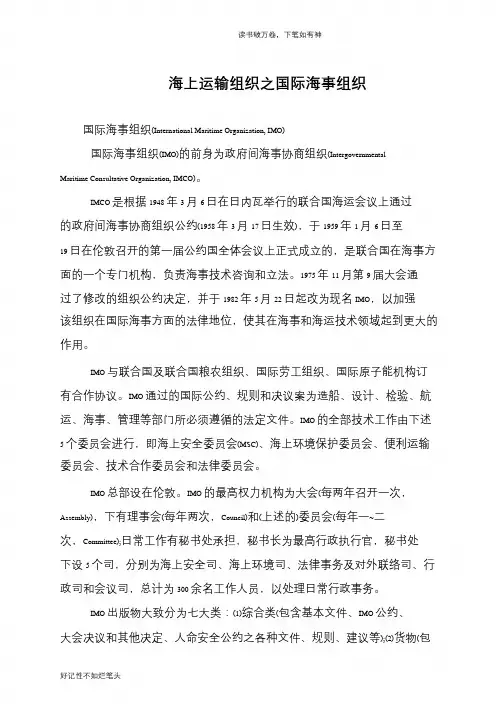
读书破万卷,下笔如有神海上运输组织之国际海事组织国际海事组织(International Maritime Organization, IMO)国际海事组织(IMO)的前身为政府间海事协商组织(Intergovernmental Maritime Consultative Organization, IMCO)。
IMCO 是根据1948 年3 月6 日在日内瓦举行的联合国海运会议上通过的政府间海事协商组织公约(1958 年3 月17 日生效),于1959 年1 月6 日至19 日在伦敦召开的第一届公约国全体会议上正式成立的,是联合国在海事方面的一个专门机构,负责海事技术咨询和立法。
1975 年11 月第9 届大会通过了修改的组织公约决定,并于1982 年5 月22 日起改为现名IMO,以加强该组织在国际海事方面的法律地位,使其在海事和海运技术领域起到更大的作用。
IMO 与联合国及联合国粮农组织、国际劳工组织、国际原子能机构订有合作协议。
IMO 通过的国际公约、规则和决议案为造船、设计、检验、航运、海事、管理等部门所必须遵循的法定文件。
IMO 的全部技术工作由下述5 个委员会进行,即海上安全委员会(MSC)、海上环境保护委员会、便利运输委员会、技术合作委员会和法律委员会。
IMO 总部设在伦敦。
IMO 的最高权力机构为大会(每两年召开一次,Assembly),下有理事会(每年两次,Council)和(上述的)委员会(每年一~二次,Committee);日常工作有秘书处承担,秘书长为最高行政执行官,秘书处下设5 个司,分别为海上安全司、海上环境司、法律事务及对外联络司、行政司和会议司,总计为300 余名工作人员,以处理日常行政事务。
IMO 出版物大致分为七大类:(1)综合类(包含基本文件、IMO 公约、大会决议和其他决定、人命安全公约之各种文件、规则、建议等);(2)货物(包好记性不如烂笔头。
了解国际海事组织及相关国际公约的概况
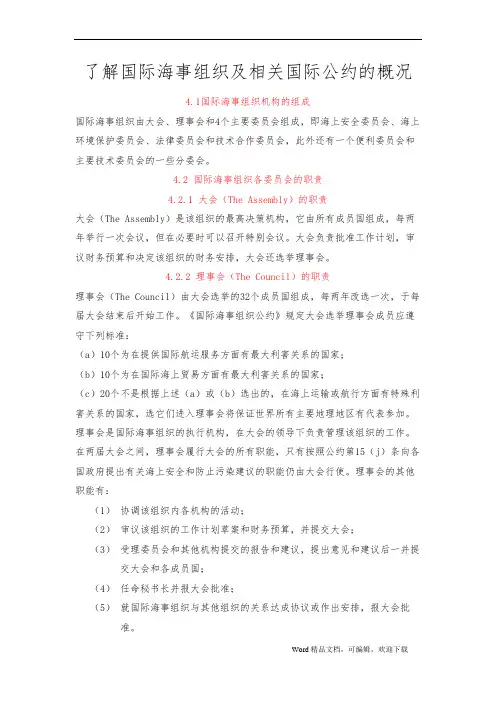
了解国际海事组织及相关国际公约的概况4.1国际海事组织机构的组成国际海事组织由大会、理事会和4个主要委员会组成,即海上安全委员会、海上环境保护委员会、法律委员会和技术合作委员会,此外还有一个便利委员会和主要技术委员会的一些分委会。
4.2 国际海事组织各委员会的职责4.2.1 大会(The Assembly)的职责大会(The Assembly)是该组织的最高决策机构,它由所有成员国组成,每两年举行一次会议,但在必要时可以召开特别会议。
大会负责批准工作计划,审议财务预算和决定该组织的财务安排,大会还选举理事会。
4.2.2 理事会(The Council)的职责理事会(The Council)由大会选举的32个成员国组成,每两年改选一次,于每届大会结束后开始工作。
《国际海事组织公约》规定大会选举理事会成员应遵守下列标准:(a)10个为在提供国际航运服务方面有最大利害关系的国家;(b)10个为在国际海上贸易方面有最大利害关系的国家;(c)20个不是根据上述(a)或(b)选出的,在海上运输或航行方面有特殊利害关系的国家,选它们进入理事会将保证世界所有主要地理地区有代表参加。
理事会是国际海事组织的执行机构,在大会的领导下负责管理该组织的工作。
在两届大会之间,理事会履行大会的所有职能,只有按照公约第15(j)条向各国政府提出有关海上安全和防止污染建议的职能仍由大会行使。
理事会的其他职能有:(1)协调该组织内各机构的活动;(2)审议该组织的工作计划草案和财务预算,并提交大会;(3)受理委员会和其他机构提交的报告和建议,提出意见和建议后一并提交大会和各成员国;(4)任命秘书长并报大会批准;(5)就国际海事组织与其他组织的关系达成协议或作出安排,报大会批准。
4.2.3 海上安全委员会(MSC)的职责海上安全委员会(MSC)是该组织的最高技术机构。
它由国际海事组织所有成员国组成。
海上安全委员会的职能是“在国际海事组织的职权范围内研究有关助航设备、船舶的构造和设备、安全配员、避碰规则、危险货物操作、海上安全程序和要求、航道信息、航海日志和航行记录、海难事故调查、救捞和救助及其他直接影响海上安全的事宜。
GMDSS概述范文
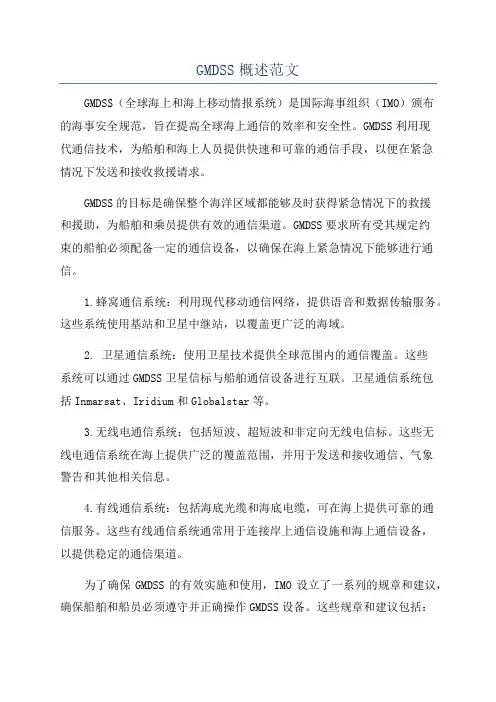
GMDSS概述范文GMDSS(全球海上和海上移动情报系统)是国际海事组织(IMO)颁布的海事安全规范,旨在提高全球海上通信的效率和安全性。
GMDSS利用现代通信技术,为船舶和海上人员提供快速和可靠的通信手段,以便在紧急情况下发送和接收救援请求。
GMDSS的目标是确保整个海洋区域都能够及时获得紧急情况下的救援和援助,为船舶和乘员提供有效的通信渠道。
GMDSS要求所有受其规定约束的船舶必须配备一定的通信设备,以确保在海上紧急情况下能够进行通信。
1.蜂窝通信系统:利用现代移动通信网络,提供语音和数据传输服务。
这些系统使用基站和卫星中继站,以覆盖更广泛的海域。
2. 卫星通信系统:使用卫星技术提供全球范围内的通信覆盖。
这些系统可以通过GMDSS卫星信标与船舶通信设备进行互联。
卫星通信系统包括Inmarsat、Iridium和Globalstar等。
3.无线电通信系统:包括短波、超短波和非定向无线电信标。
这些无线电通信系统在海上提供广泛的覆盖范围,并用于发送和接收通信、气象警告和其他相关信息。
4.有线通信系统:包括海底光缆和海底电缆,可在海上提供可靠的通信服务。
这些有线通信系统通常用于连接岸上通信设施和海上通信设备,以提供稳定的通信渠道。
为了确保GMDSS的有效实施和使用,IMO设立了一系列的规章和建议,确保船舶和船员必须遵守并正确操作GMDSS设备。
这些规章和建议包括:1.GMDSS救援协调中心(RCC):每个国家都设有至少一个RCC,负责接收和处理海上紧急情况的报警信号,并调度救援资源。
船舶在发生紧急情况时,应向最近的RCC发送救援请求。
2.GMDSS设备建议:IMO建议船舶在航行中配备一套符合GMDSS要求的通信设备,以确保在紧急情况下能够及时获救。
3.GMDSS培训要求:IMO规定船上必须有经过GMDSS培训的乘员,以确保他们能够正确使用GMDSS设备并处理紧急情况。
4.GMDSS设备检查要求:船舶必须定期进行GMDSS设备检查,并确保其正常工作和良好运行。
国际海事组织的历史和现状
,匕、匕》嚼二峨:日`、以加匕
之、``:曰`》山二、匕国`拐
二日`习心盏g、峨》山亡、自刊`含山`1匕、翻二》翻为``、匕知匕二臼`5七飞`巴
国标海事组织的历史和现状危敬添习£二幽习`、`为山口二目记,扭》目之J记、二3`尧妇二、匕、一口4`定巴二`~匕目`)山`山匕倒匕、翻二习``、翻二》``、比习`杏咤`1948年2、3月间,联合国在日内瓦召开海运会议,讨论并通过了《政府间海事协商组织公约》。该公约于1958年3月17日生效。据此,1959年1月13日在’伦敦正式成立政府间海事协商组织,兑召开了第一届大会。根据1975年11月召开的第九届大会通过的组织公约修正案,该组织自1982年5月2日起改名为国际海事组织,该组织自成立之日起即是联合国系统中负责处理海运技术问题的一个专门机构。该组织的宗旨是促进各国间的航运技术合作,鼓励各国在促进海上安全、提高船舶的航行效率,防止租控制船舶对海洋污染方面米用统一的标准,并处理与此有关的法律间题。我国于1973年3月1日加入该组织,截至1989年1月9日,该组织共有13个正式会员和一个联系会员(香港)。会员国名单及其入会的年份见附件。该组织的总部设在英国伦敦,现任秘书长斯里瓦斯塔瓦tC.P.Srivasatva〕印度人,他翻1974年1月1日起担任此职,并曾三次竞选连任,至1989年12月31日任期届满。新的秘书长将由1989年6月份召开的理事会第62届会议确定人选后报10月召开的第16届大会批准,于1990年1月1日就职。曾经另任过此职的有:少分麦的OveNielsen,英国的WilliamGraham,法国的JeanRoullier,和英国的ColinGoa’d。46该组织由大会、理事会、海上安全委员
会,法律委员会、海洋环境保护委员会、技术合作委员会、便利运输委员会和秘书处组成。大会由全体会员国代表组成,是该组织最高权力机构,每两年召开一次例会,其任务是批准工作什划和财务预算,选举理事会成员国,审议并通过各委员会提出的有关海上安全、防止海洋污染及其他有关规则的建议案。1989年10月将召开第16届大会。理事会由大会选出的32个理事国组成,并分三类进行选举,第一类是8个在提供国际航运服务方面具有最大利害关系的国家
国际海事组织
国际海事组织 (International Maritime Organization -- IMO) 是联合国负责海上航行安全和防止船舶造成海洋污染的一个专门机构,总部设在伦敦。
该组织最早成立于1959年1月6日,原名“政府间海事协商组织”,1982年5月改为现名,现有167个正式成员。
香港特别行政区和澳门特别行政区为该组织联系成员。
该组织宗旨为促进各国间的航运技术合作,鼓励各国在促进海上安全,提高船舶航行效率,防止和控制船舶对海洋污染方面采取统一的标准,处理有关的法律问题。
下设有海上安全委员会、海洋环境保护委员会、技术合作委员会、法律委员会。
国际海事组织理事会共有40名成员,分为A、B、C三类。
其中10个A类理事为在提供国际航运服务方面有最大利害关系的国家,Council members for the 2008-2009 bienniumCategory (a): 10 States with the largest interest in providing international shipping services:China Greece Italy Japan Norway PanamaRepublic of Korea Russian Federation United Kingdom United states10个B类理事为在国际海上贸易方面有最大利害关系的国家,Category (b): 10 other States with the largest interest in international seaborne trade:Argentina Bangladesh BrazilCanadaFrance GermanyIndiaNetherlands Spain Sweden20个C类理事为在海上运输或航行方面有特殊利害关系并能代表世界主要地理地区的国家。
Category (c): 20 States not elected under (a) or (b) above which have special interests in maritimetransport or navigation, and whose election to the Council will ensure the representation of all major geographic areas of the world:Australia Bahamas Chile Cyprus Denmark Egypt Indonesia Jamaica KenyaMalaysia Malta Mexico New ZealandNigeria Philippines SaudiArabiaSingaporeSouthAfrica Thailand Turkey理事会是该组织的重要决策机构。
国际海事组织的结构与活动概况
即
海 丰航 行安 全
一
无线 电 通 孤 人命 安全
、
、
搜
、
,
索 与救 助
、
培 训 标 准 与 谭班 船 舶稳 性
、
船 舶 设 计 与装
(
1
)
、
海 事 大会
。`
。
侮事 大会 是 海 事组
19韵
豁
(
消防
`
。
、
载 重 线 与 渔 船安 全
织 的最 高权 力 机构 议
,
’
它每 两年 召开 “ 次 会 年 n 月将 召开 1 6
术合 作 活 动
( 7 )
。
它对 所 有 的 会 员开 放
处理 本 组织 范 围内的 任 何 法 律事 宜 员会包 括 所 有 的 会员
使利 运 翰委 员 会
便利 运 输 委 员 会
,
与 国 际 海事 组织的 其 他 委员会 不 同
国际 海事 组 织 秘 书 处
结率J图
它 是理
一
一
一 一 猫
一 ù F一 公 价 召
在1 9
8 8年 9
月
,
海环 保 会 召并 了 第
( 法 你委 员 会
。
届会 议
,
。
(
6
) 技术 合 作委 员 会
除 了 其 它职 责外
。
,
法 律委 员会 放 1 9
。
年
) 术合 作委 员会 主 要 从 7 事 海事 组织 的 各种 技 技
成立
除 其 它的 职 责 外
。
法律 委 员会 主 要是 法律委
,
集 装箱 与 货 物 运 输 和散 装 化学 品务 委 会
第01讲国际海事组织
1960 1993 1966 1959 1970 1995 1991 1961 1989
105 Netherlands 106 New Zealand 107 Nicaragua 108 Nigeria 109 Norway 110 Oman 111 Pakistan 112 Palau 113 Panama Papua New Guinea 114 115 Paraguay 116 Peru 117 Philippines 118 Poland 119 Portugal 120 Qatar 121 Republic of Korea Republic of Moldova
1949 1960 1982 1962 1958 1974 1958 2011 1958
129 San Marino 130 Malaysia 131 Saudi Arabia 132 Senegal 133 Serbia 134 Seychelles 135 Sierra Leone 136 Singapore 137 Slovakia Venezuela (Bolivarian Republic of) 138 139 Solomon Islands 140 Somalia 141 South Africa 142 Spain 143 Sri Lanka 144 Sudan 145 Suriname Saint Vincent and the Grenadines
1995
1976 1976 1976 1970 1951 1990 1980 1959 1993 1963 1984 1960
28 Comoros
29 Congo 30 Cook Islands 31 Costa Rica 32 Côte d'Ivoire 33 Croatia 34 Cuba 35 Cyprus 36 Czech Republic Democratic People's 37 Republic of Korea Democratic Republic of 38 the Congo* 39 Denmark 40 Djibouti
- 1、下载文档前请自行甄别文档内容的完整性,平台不提供额外的编辑、内容补充、找答案等附加服务。
- 2、"仅部分预览"的文档,不可在线预览部分如存在完整性等问题,可反馈申请退款(可完整预览的文档不适用该条件!)。
- 3、如文档侵犯您的权益,请联系客服反馈,我们会尽快为您处理(人工客服工作时间:9:00-18:30)。
国际海事组织综述摘要国际海事组织是联合国负责海上航行安全和防止船舶造成海洋污染的专门机构,是联合国体系中的重要一员,本文通过对国际海事组织背景、组织结构、重要贡献以及未来发展的介绍说明了国际海事组织对于各国航运市场、航运安全以及海洋环境的重要作用。
本文也在文中特别讨论了国际海事组织与中国的联系。
关键词:国际海事组织背景组织结构贡献未来发展中国AbstactInternational Maritime Organization is one of the the specialized agencies in United Nation,which is responsible for maritime safety and the prevention of marine pollution from ships,and in the United Nation system it is also an important part .Thistext is based on the background, organization structure, important contribution and the future development of the International Maritime Organization to illustrate the importance of International Maritime Organization for the world shipping market, the shipping safety and marine environment important . This paper has also discussed in detail the International Maritime Organization 's relationship with china.Key word: IMO;Background;Organization structure;Importantcontribution; Future development ; China国际海事组织综述国际海事组织背景(一)国际海事组织的成立国际海事组织(International Maritime Organization,简称IMO)是作为联合国体系中的一员,负责海上航行安全和防止船舶造成海洋污染的专门机构。
119世纪以来,随着国际贸易的发展,各国的船队在国际海洋中畅行,随之而来由于各国家管辖地域内有关海事的标准、习惯和法律的不同,有关海事的国际纠纷日益增加,除此之外,海上安全也越来越得到各国的关注。
由此,建立一个统一的国际组织的呼声越来越强烈。
1948年有关建立国际海事国际公约在日内瓦联合国大会中通过,并与1959年1月6日成立,命名为“政府间海事协商组织”。
1982年5月正式更名为国际海事组织。
作为第一个官方的国际海事组织其宗旨为促进各国间的航运技术合作,鼓励各国在促进海上安全,提高船舶航行效率,防止和控制船舶对海洋污染方面采取统一的标准,处理有关的法律问题。
其组织形式、职能、程序均有国际海事组织公约及其修正案规定。
(二)国际海事组织的组织结构该组织的总部位于伦敦,截止2012年3月国际海事组织共吸纳了169个成员国以及三个联系成员,以及300名左右的国际工作人员为其服务。
2每两年举行一届的大会是该组织的最高决策机关,而由40名成员国组成的安理会是其决策执行机关,并且国际海事组织下设了五个委员会,分别为海上安全委员会、海上环境保护委员会、技术合作委员会、法律委员会、便利交通委员会。
该五个委员会下又设立多个分委员会辅助其工作。
各机关的地位、成员以及职能如下:1.国际海事组织大会是其最高的决策机关,由所有成员国成员参加,每两年举行一次常会,有三分之一的会员通知秘书长要求召开大会或当理事会认为有1/view/186056.htm#sub6148454百度百科2http://国际海事组织官网必要召开大会时,在发出召开大会的通知60天后举行大会的特别会议。
其主要负责组织未来的工作计划、预算计划的投票、决定财政安排以及选举理事会成员。
大会表决制度为“特定多数”制,即经出席大会及投票的成员国的三分之二多数同意才能通过。
2.国际海事理事会是其决策执行机关并且监督组织活动,由大会每两年选举的40名成员国组成,成员国可以连选连任。
其主要职能是在大会闭会期间履行除了国际组织公约第15条j款的有关规定的大会的职能,另外理事会的职能还包括:(1)协调组织机关活动;(2)考虑组织文件起草工作以及预算的评估,并且将其提交给大会;(3)接受委员会以及其他机关的报告和建议,并附以适当的建议和意见提交给大会;(4)经大会同意,任命秘书长;(5)经大会同意,签订有关该组织和其他组织关系的协议和安排。
该40名成员国被分为A、B、C、三类,其中A类成员国为对国际航运服务影响最大的十个国家,在2012年至2013年度,该10个国家分别为中国(截止2012年连续12次被选为A类理事国),希腊,意大利,日本,挪威,巴拿马,朝鲜共和国,俄罗斯,英国,美国。
B类成员国为对国际海运贸易影响最大的十个国家,在2012年度至2012年度该10个国家分别为阿根廷,孟加拉国,巴西,加拿大,法国,德国,印度,荷兰,西班牙,瑞典。
C类成员国为对国际海上运输和航行有特殊作用的但未进入A类和B类的国家,并且考虑世界主要地理区域均有代表,在2012年度至2013年度这些国家为巴哈马群岛,澳大利亚,比利时,丹麦,智利,塞浦路斯,埃及,印度尼西亚,牙买加,肯尼亚,利比里亚,马来西亚,马耳他,墨西哥,菲律宾,新加坡,以色列,南非,泰国,土耳其。
截止2012年1月加入国如下:Instruments received – January 2012Country or territory Treaty InstrumentdepositedDate ofdepositDate of Entryinto forceTrinidad and Tobago AFS Convention 2001 Accession 03-Jan-12 03-Apr-12 Trinidad and Tobago BWM Convention 2004 Accession 03-Jan-12 Not yet in force Yemen SOLAS Protocol 1988 Accession 11-Jan-12 11-Apr-12 Yemen LL Protocol 1988 Accession 11-Jan-12 11-Apr-12 Ireland LLMC Protocol 1996 Accession 25-Jan-12 24-Apr-12 Montenegro SOLAS Protocol 1988 Accession 27-Jan-12 27-Apr-12Montenegro LL PROT 1988 Accession 27-Jan-12 27-Apr-12 Barbados AFS Convention 2001 Accession 30-Jan-12 30-Apr-123.海事安全委员会是组织的最高技术机构,由所有成员国组成。
该委员会的主要职能为(1)考虑在组织职责范围内的有关航标、船舶建设和设备、安全船舶的配备、避碰规则、危险货物处置、海事安全程序和要求、水文信息、航海日志和航行记录、海上事故调查、救助打捞和其他直接与海上安全有关的事项;(2)该委员会还负责为履行由国际海事组织公约分配的责任以及任何为其他国际性文件赋予并被国际海事组织接收的责任提供机构设备;(3)其有责任考虑并提交建议和指导方针给可能由大会通过的有关安全方面文件。
(4)被扩大的海事安全委员会可以通过例如海上人命安全公约等公约的修正案。
并且该委员会可以包括公约的成员国即使其不是国际海事组织的成员。
4.海洋环境保护委员会初期是作为大会的附属机关,在1985年才获得其独立的法律地位。
其由所有成员国组成,该委员会的只要职能为考虑组织职权范围内有关船舶污染的防治和控制的事项。
特别是有关公约、其他规范性文件以及确保其实行的措施的通过和修订。
5.技术合作委员会在1969年作为理事会的一个附属机构存在,与1984年生效的国际海事组织公约修订案的方式成为组织下属委员会。
其由组织所有成员国组成。
其职能为考虑组织职责范围内有关共同合作项目的实施的事项(组织作为技术合作项目的执行者以及合作机构)以及在技术合作领域有关组织活动的事项。
6.法律委员会在1967年以一个附属机构的名义存在去处理由“托里坎荣”号海难所引发的法律问题。
其由组织所有成员组成。
其职能是处理组织职责之内的所有法律问题以及履行任何其他法律文书规定或授权并为组织接收的的其他职责。
7.便利交通委员会在1972年5月作为理事会的附属机构存在并与2008年12月通过国际海事组织公约修正案转化成一个具有独立地位的委员会。
其由组织所有成员组成。
其职能为通过各方面实施1965年便利国际海上运输公约消除不必要的手续和国际航运的繁文缛节以及处理组织职责范围内有关国际海上交通便利的事项。
最近几年该委员会的工作为确保海事安全和国际海事贸易便利两者之间的权利平衡。
另外国际海事组织行政事务由秘书处主管,其由秘书长以及300名左右的国际工作人员组成,于2012年1月开始,国际海事组织秘书长由来自日本的关水康斯(sekimizu)3担任。
国际海事组织历史大事件1948年于日内瓦举行的联合国海事会议中国际海事组织公约的通过,满足了国际社会的希望,为成立一个具有制定国际海事统一规范的能力和地位的组织奠定了基础。
该公约与1958年生效,并与1959年国际海事组织正式成立。
1960年,组织通过了1960年国际海上人命安全公约(International Convention for the Safety of Life at Sea 1960 简称SOLAS 1960),随后国际海事组织将工作重点部分转向便利国际海上交通、载重线以及危险物运输等方面,同时修订了船舶吨位测量系统。
由于海上油类运输的普及以及油轮数量的增加,海洋污染越来越严重并且得到了国际社会的重视。
特别是1967年“托里坎荣”号海难发生,导致120,000吨原油倾泻并造成大面积海洋污染,国际海事组织在1969年和1971年通过两个公约建立一个系统使海洋油污造成经济损失后受害者获得赔偿更加简便和迅速。
随后组织又于1973年通过了国际防止船舶造成污染公约并于1978年通过该公约的议定案。
